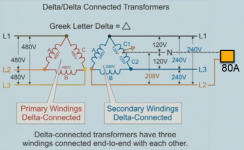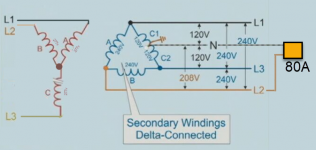The current in a transformer secondary coil is related to the magnetic field in the transformer core created by the primary coil current. The magnetic field cannot 'flow' in two directions at once if there is only one magnetic circuit. This is a constraint you need to include in your analysis.
OK, my understanding of the magnetic circuit, and how that affects the electrical circuit, is definitely very weak. If you have a pointer to where I could learn about that it would be super appreciated.
Right now my analysis is just based on the idea that if the turns ratio is T, then the voltage ratio will be T (and in phase), and the current ratio will be 1/T (and in phase). So if there's something about the magnetic circuit that I'm missing, and that changes the ultimate result, one of those rules will need to be modified.
But let's amend the diagram in post #8 so that (a) the transformer is built up from 3 separate single phase transformers (separate cores) and (b) the C transformer is further split into two separate 480V : 120V transformers C1 and C2. The analysis in post #8 should then apply, as I have removed all magnetic circuit / common core constraints.
Is that correct? So primaries C1 and C2 would see would see opposite sign currents. If they are jointly supplied by a 2 wire feeder (not shared with transformers B and C), the current in that feeder would be zero. There would just be a circulating current around the primary C1 / C2 loop, which is possible in this impedance free idealization.
So then if go back to a single C transformer with split secondary coil, what changes? I have trouble seeing how any imbalance could be introduced, as the circuit has mirror symmetry (at least for the case of a resistive load on L2 - N).
Thanks,
Wayne


